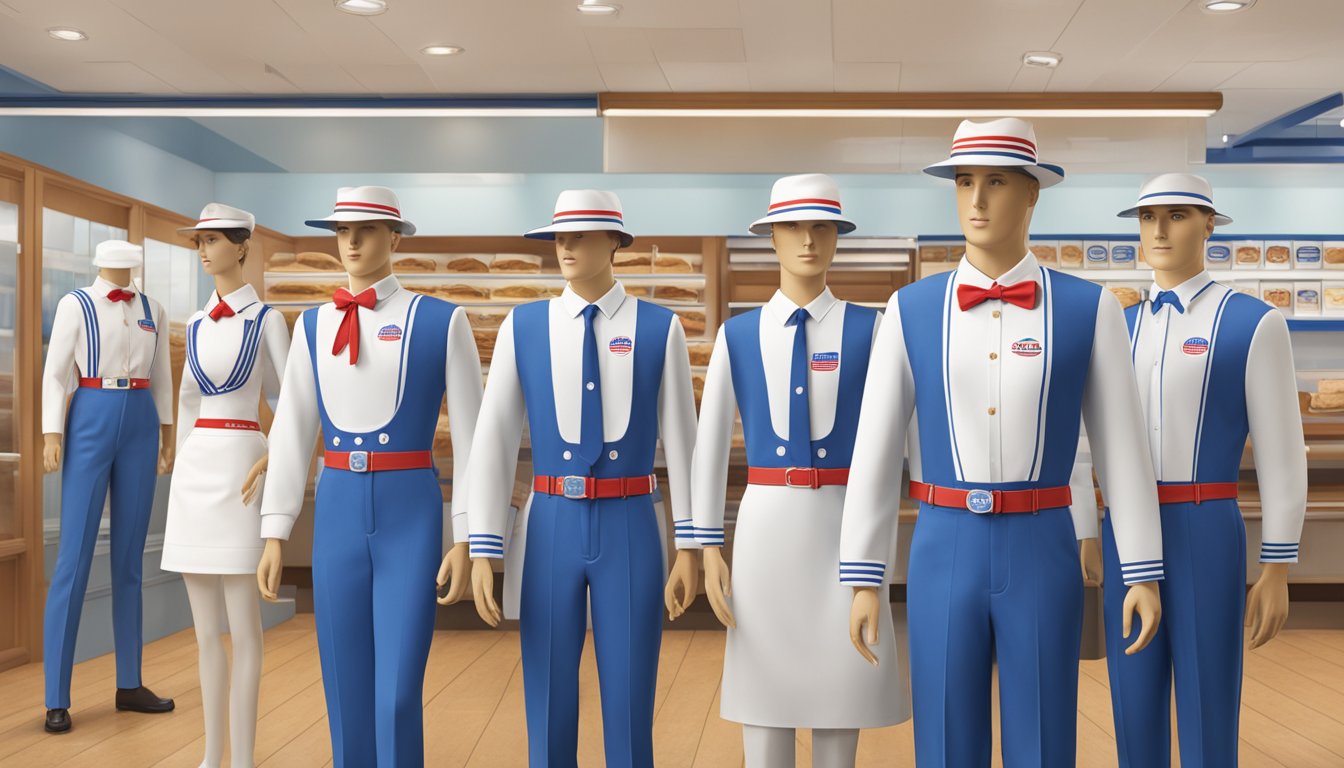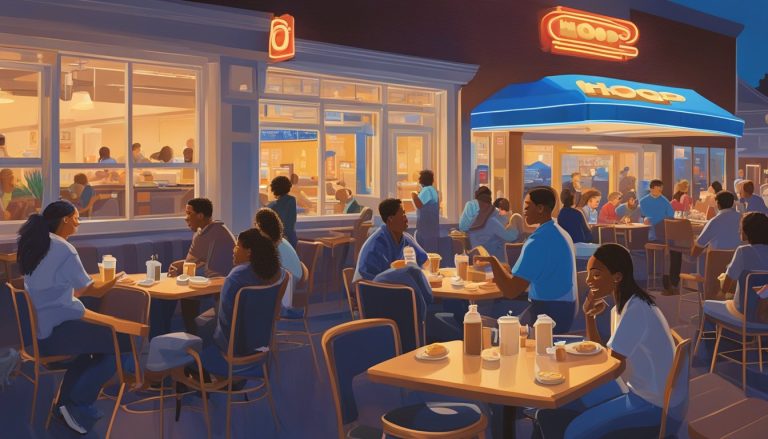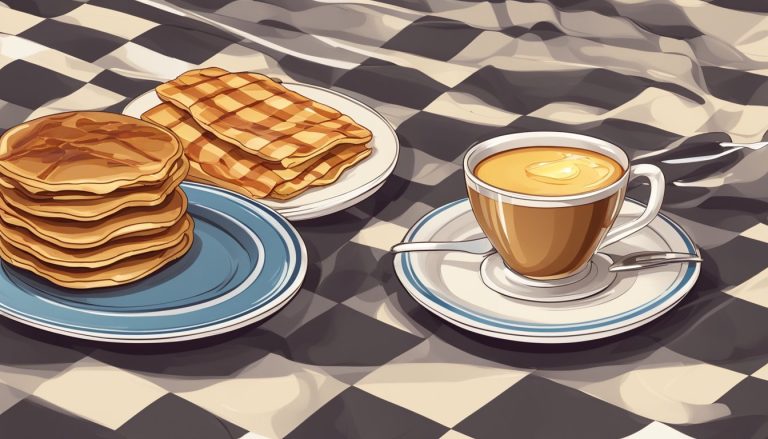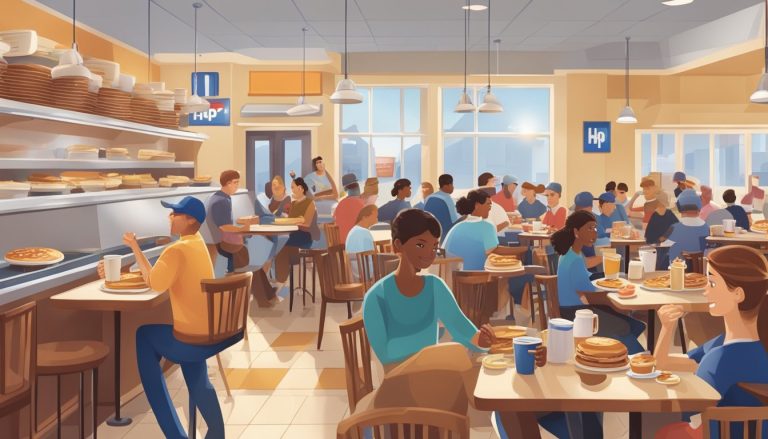Since its inception in 1958, IHOP has become a beloved American institution, serving up pancakes and hospitality in equal measure. The IHOP uniform has played a crucial role in shaping the brand’s identity and customer experience over the decades.
The iconic blue and white color scheme of the IHOP uniform has remained a constant throughout the years, evolving in style while maintaining its recognizable essence. From crisp white shirts and navy aprons in the early days to more modern, streamlined designs, the uniform has adapted to changing fashion trends while always embodying the friendly, approachable spirit of the restaurant chain.
As IHOP expanded across the United States and beyond, its uniform became a symbol of consistency and quality service. The evolution of the IHOP uniform reflects not only changes in fashion but also shifts in the restaurant industry and American culture at large. Through economic ups and downs, cultural revolutions, and technological advancements, the IHOP uniform has remained a steadfast representation of the brand’s commitment to providing a welcoming dining experience for all.
Foundation and Brand Evolution

IHOP’s journey from a small pancake house to a global brand icon is marked by strategic decisions and evolving visual identity. The company’s growth reflects changing consumer tastes and restaurant industry trends over decades.
Origins of IHOP
IHOP, originally known as International House of Pancakes, was founded in 1958 by Al and Jerry Lapin in Toluca Lake, Los Angeles. The brothers aimed to create a restaurant specializing in breakfast foods, particularly pancakes.
IHOP’s initial menu focused on pancakes with various toppings and syrups. This unique concept quickly gained popularity, leading to rapid expansion through franchising in the 1960s.
By 1970, IHOP had grown to over 300 locations across the United States, establishing itself as a major player in the casual dining sector.
Brand Image and Identity
IHOP’s brand identity centers around its reputation as a family-friendly restaurant offering affordable, quality breakfast options. The company’s blue and white color scheme became a recognizable part of its visual branding.
In the 1970s and 1980s, IHOP expanded its menu beyond breakfast to include lunch and dinner items. This move broadened its appeal and helped establish IHOP as an all-day dining destination.
IHOP’s uniforms evolved to reflect its brand identity. Employees typically wear blue shirts or aprons with the IHOP logo, reinforcing the company’s color scheme and professional image.
Logo Changes Through the Years
IHOP’s logo has undergone several transformations since its inception, each reflecting the brand’s evolution and contemporary design trends.
The original logo featured a simple wordmark with “International House of Pancakes” spelled out in full. In the 1970s, IHOP introduced its iconic “smile” logo, with the letters IHOP forming a smiling face.
1990s: IHOP adopted a more modern look with a stylized blue roof over the IHOP letters.
2015: The company unveiled a refreshed logo featuring a smiley face incorporated into the “o” of IHOP, emphasizing its friendly, welcoming image.
These logo changes have helped IHOP maintain a contemporary image while preserving key elements of its brand identity.
Uniform Design Over Time

IHOP uniforms have undergone significant changes since the restaurant’s inception in 1958. The iconic blue and white color scheme has remained a constant, while styles and cuts have evolved to reflect changing fashion trends and employee preferences.
The Original IHOP Uniforms
The first IHOP uniforms featured a classic diner-inspired look. Female servers wore light blue dresses with white collars and cuffs. The dresses had a fitted waist and flared skirt, reaching just below the knee. Male servers sported crisp white shirts, dark blue ties, and black slacks.
These original uniforms projected a clean, professional image that aligned with IHOP’s family-friendly atmosphere. The distinct blue color quickly became associated with the IHOP brand, helping to establish visual recognition among customers.
Decadal Shifts in Style
In the 1970s, IHOP uniforms embraced a more casual look. Polyester became the fabric of choice for its durability and easy maintenance. Women’s uniforms shifted to separates, with blue tops paired with matching slacks or skirts.
The 1980s saw a return to dresses for female staff, but with updated silhouettes. Shoulder pads and tapered waists reflected the decade’s fashion trends. Male uniforms remained relatively consistent, with minor updates to shirt styles and tie widths.
Incorporation of Trends
IHOP has made efforts to keep uniforms current while maintaining brand identity. In the 1990s and 2000s, uniforms became more relaxed and comfortable. Polo shirts replaced button-ups for male staff, while women had the option of pants or skirts with coordinating tops.
Recent years have seen a focus on breathable fabrics and flexible fits to accommodate long shifts and diverse body types. The classic blue color has been complemented by subtle pattern additions and modern cuts to keep the look fresh and appealing.
Uniform Customization and Personalization
IHOP has recognized the importance of individual expression within uniform guidelines. Servers can now choose from a range of approved styles that suit their preferences and body types. This includes options like short or long sleeves, different necklines for women, and varying pant styles.
Name tags have evolved from simple pinned badges to embroidered names on uniforms, creating a more personalized appearance. Some locations allow staff to wear approved accessories or flair, letting personalities shine through while maintaining a cohesive look.
These customization options have helped boost employee satisfaction and comfort without compromising the recognizable IHOP aesthetic. The balance between uniformity and individuality continues to be a key consideration in IHOP’s uniform design process.
Functionality and Comfort

IHOP uniforms blend practicality with style, prioritizing employee comfort and efficiency. The design considers the fast-paced restaurant environment, allowing staff to move freely while maintaining a polished appearance.
Material Considerations
IHOP selects fabrics for their uniforms that balance durability with comfort. Breathable cotton blends are often used to keep employees cool during long shifts. These materials resist wrinkles and stains, maintaining a neat appearance throughout the workday. Stretch fabrics are incorporated into pants and shirts, allowing for ease of movement when bending, reaching, or carrying trays.
Design for Mobility
The uniform’s cut and fit are tailored for the demands of restaurant work. Shirts feature a relaxed fit to allow unrestricted arm movement when serving dishes. Pants are designed with a slight stretch and reinforced seams to withstand frequent bending and squatting. Aprons are adjustable and lightweight, providing protection without hindering movement.
Maintenance and Durability
IHOP uniforms are engineered for longevity and easy care. Stain-resistant treatments help repel food and beverage spills. The fabrics are colorfast to withstand frequent washing without fading. Reinforced stitching at stress points, such as pockets and buttonholes, extends the uniform’s lifespan. Many components are machine washable and quick-drying, allowing employees to maintain a fresh appearance with minimal effort.
Cultural Impact

The IHOP uniform has become a recognizable symbol in American dining culture. Its distinctive blue and white color scheme has left an indelible mark on the restaurant industry and popular imagination.
Pop Culture References
IHOP uniforms have appeared in various movies and TV shows, often symbolizing the quintessential American diner experience. In some sitcoms, characters donning IHOP attire represent the struggles of working-class America. The uniform’s presence in media has cemented its status as a cultural icon.
Notable film appearances include scenes in road trip movies, where characters stop at IHOP for a late-night meal. These moments often serve as turning points or bonding experiences for the characters, highlighting the restaurant’s role in American social life.
Television shows have also featured IHOP uniforms in episodes centered around part-time jobs or small-town life. This representation has helped solidify the uniform’s place in the collective cultural consciousness.
Uniforms as Marketing Tools
IHOP has strategically used its uniforms as powerful marketing assets. The consistent blue and white color scheme across all locations creates instant brand recognition.
The company has occasionally updated the uniform design to reflect current fashion trends while maintaining its core elements. These updates generate buzz and media attention, effectively serving as free advertising.
IHOP merchandise featuring the iconic uniform design has become popular among fans. T-shirts, aprons, and other items sporting the IHOP logo and uniform colors are sold as collectibles, further extending the brand’s reach.
During promotional events, IHOP sometimes allows customers to wear elements of the uniform, creating interactive experiences that boost engagement and social media sharing.
Employee and Customer Perceptions
IHOP employees often report mixed feelings about their uniforms. Many appreciate the practical design and ease of maintenance. The recognizable outfit can instill a sense of pride and belonging to a well-known brand.
Some employees, however, find the uniforms outdated or uncomfortable. This has led to ongoing discussions about balancing tradition with modern workplace expectations.
Customers generally associate the IHOP uniform with friendly service and comfort food. The familiar attire creates a welcoming atmosphere that aligns with the restaurant’s family-friendly image.
For many patrons, seeing an IHOP uniform evokes nostalgia, reminding them of late-night study sessions or family outings. This emotional connection has helped maintain IHOP’s loyal customer base over the years.
Current Uniforms and Brand Representation

IHOP’s uniforms have evolved to reflect modern design trends while maintaining the company’s iconic identity. The current attire balances functionality with brand recognition, serving as a visual representation of IHOP’s values and customer experience.
Latest Uniform Iteration
IHOP’s current uniform features a blue button-up shirt paired with black slacks. The shirt incorporates the company’s logo and signature blue color, creating a cohesive look across all locations. Employees also wear black non-slip shoes for safety and comfort during long shifts.
The design prioritizes practicality, allowing staff to move easily while serving customers. Aprons are often part of the ensemble, providing additional protection and storage for essential items.
Adaptation to Contemporary Branding
IHOP’s uniform has adapted to reflect the company’s modern image. The current design incorporates sleek lines and a more fitted silhouette, moving away from the looser styles of previous decades.
The color palette now focuses on a crisp blue and white combination, aligning with IHOP’s updated visual branding. This change helps create a fresh, clean atmosphere in restaurants.
Accessories like name tags and optional hats complete the look, adding a personal touch to the uniform.
Role in Brand Strategy
IHOP’s uniform plays a crucial role in its brand strategy. The consistent appearance across locations reinforces brand recognition and customer trust. Staff uniforms serve as walking advertisements, instantly identifying employees and reinforcing IHOP’s presence.
The uniform also contributes to the overall dining experience. Its professional appearance sets expectations for service quality and cleanliness. IHOP uses the uniform to differentiate itself from competitors and create a unique visual identity in the crowded restaurant industry.
By regularly updating uniforms, IHOP demonstrates its commitment to staying current and relevant to its customer base.
Future of Fashion at IHOP

IHOP’s uniform evolution continues to blend tradition with innovation. The iconic brand looks toward fresh designs, eco-friendly materials, and cutting-edge production techniques to outfit its staff.
Predictions and Trends
IHOP uniforms are poised for a modern refresh. Expect to see sleeker silhouettes and performance fabrics that offer comfort and flexibility. Colors may expand beyond the classic blue and white, incorporating subtle brand-inspired hues. Customizable elements could allow staff to express individuality while maintaining a cohesive look.
Athleisure influences may emerge, with stretch materials and breathable fabrics becoming standard. This shift would enhance employee comfort during long shifts. Accessories like branded pins or interchangeable patches might be introduced, allowing staff to personalize their uniforms.
IHOP may also explore limited-edition uniforms for special promotions or seasons, creating buzz and collectible appeal among staff and customers alike.
Sustainability and Ethical Considerations
Environmental consciousness is set to play a significant role in IHOP’s uniform future. The company is likely to adopt eco-friendly fabrics made from recycled materials or sustainable sources. Biodegradable packaging for uniform distribution could further reduce environmental impact.
Ethical manufacturing practices will become a priority. IHOP may partner with suppliers who ensure fair labor conditions and transparent supply chains. This commitment would align with growing consumer expectations for corporate responsibility.
Uniforms might be designed for longevity, reducing waste and replacement frequency. IHOP could implement a recycling program for worn-out uniforms, repurposing materials into new garments or promotional items.
Technological Advancements in Uniform Production
Smart textiles may revolutionize IHOP uniforms. Fabrics with moisture-wicking and temperature-regulating properties could enhance staff comfort in busy kitchen environments. Stain-resistant treatments would maintain a professional appearance throughout shifts.
3D printing technology might enable custom-fit uniforms, reducing alterations and improving employee satisfaction. Digital design tools could streamline the prototyping process, allowing IHOP to quickly iterate and test new uniform concepts.
RFID tags embedded in uniforms could assist with inventory management and loss prevention. These tags might also integrate with smart lockers or automated uniform dispensing systems, improving efficiency in large IHOP locations.




